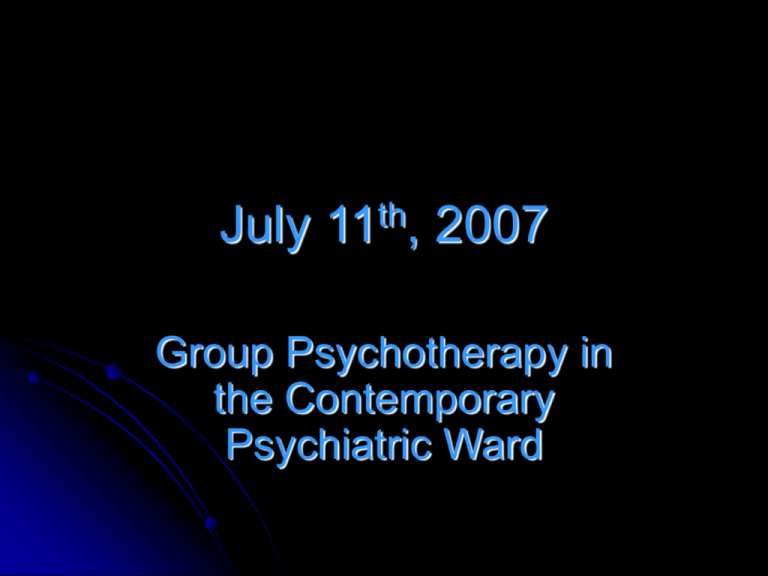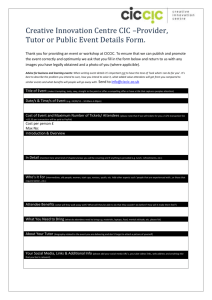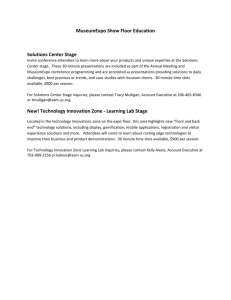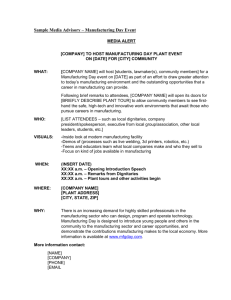From Obstacles to Stepping Stones
advertisement

July 11th, 2007 Group Psychotherapy in the Contemporary Psychiatric Ward “From Obstacles to Stepping Stones” Background: Safety, Privacy and Dignity. Post of Group Therapy Development Officer 2001 Scottish Executive Audit : Safety, Privacy and Dignity Psychotherapy Dept consulted 2004 Job description agreed and post appointed October 2005 Post activated in Feb 2006. Key Elements of Post “ ….to facilitate the development of group therapy and reflective practice……in the five acute admission wards, in the first instance.” “To lead the development of this new clinical service via service provision, training, supervision and reflection in five teams.” “Rights, Relationships and Recovery” “Recovery is often described as a long-term process or “journey” and is not simply the absence of symptoms. It is based on hope, involvement, participation, inclusion, meaning, purpose, control and self-management and emphasises the importance of peer support, meaningful activity, employment, maintaining social networks and activities when distressed and having the chance to contribute, or giveback, in some way.” ( p18,RRR) “Rights, Relationships and Recovery.” “Acute inpatient care is an area in which mental health nurses sometimes feel compromised in their ability to deliver rights, principles and recovery-focused care.” ( p24, RRR) “…inpatient care is struggling against a culture of risk-averse, defensive practices……..serves to stifle some aspects of practice development and undermines efforts to meaningfully engage with service users and carers.” ( p24 RRR) The First Year Who?..What?...Why?...How? “Who am I and what am I doing here?” “Who are you and what do you do here?” “What is your experience of here?” “ Why are you / they doing that?” “How might we improve your experience?” “Hello, my name is…….” “My Early Countertransference……..” Lost Afraid Bewildered…..and tired I think I was beginning to really understand the experience of both the service user and the staff member. Many service users had told me of feeling lost, afraid and bored. Many staff had described bewilderment, fatigue and frustration. A Paradigm Shift? Countertansference Resonance Heinz Kohut’s emphasis on “ experience near” subjectivity and empathy. A more systemic approach? Preliminary Work Coping with Change, Loss and Location Asking and listening Discussions Consultations Training Implementation Psychotherapy Dept The Challenges………………….. Space “Busy…busy….busy….” Academia !!! The Debating Society The Fears : Fighting The Fears : Despair and Paranoia The fears : Distress and…. …..and hugging. The Hopes “There needs to be greater valuing of and support for the highly skilled nature of working with people with acute mental health problems.” ( p25, RRR) Training Support Supervision / Reflective Practice Protected time Role extension Hopes Nurses need to and want to.. “maximise time to build Relationships.....based on principles in legislation, safeguards and codes of conduct ( Rights)….to listen to what people say….to see the whole person and not just his/her symptoms ( Respect)…..and to promote Recovery and inspire hope.” ( p14, RRR) Tell me what to do and how to think. Staff were keen to have a theory Theories are not hardened truths, rather shared interactive constructions which emerge and have utility in certain situations Theory helps therapist and the group contain and modify powerful and chaotic affects Key concept in group analysis is a communications network Yalom’s Therapeutic Factors, particularly: Yalom’s Therapeutic Factors Instillation of Hope Universality Imparting Information Altruism The corrective recapitulaltion of the primary family group Development of socialising techniques Imitative behaviour Interpersonal Learning Group Cohesiveness Catharsis Existential Factors Setting Realistic Goals Largely driven by patients Context Composition Difficulties Previous Experience Staff Hopes and Fears Encouraging staff to be realistic Some numbers…. Ward A has had 55 from a possible 73 groups This equates to 75.3% Average number of attendees per group was 4 Highest number of attendees was 6 Lowest number was 2, not technically a group but often time well spent. Over six months 242 possible attendees ( from people assessed as able to attend) Actual attendees was 175 This equates to 72.31% “The Leap of Hope” More numbers….. Ward B has had a more difficult start. Of a possible 51 groups there have been 33 This equates to 64.7% Average number of attendees is 3.5 Highest number of attendees is 6 Lowest number of attendees 2 Over 5 months possible attendees was 186 Actual number of attendees 116 Fresh numbers….. Ward C recently commenced, on June 12th. Of a possible 9 groups there have been 9 groups, this equals 100% Possible number of attendees was 50 Actual number of attendees was 43 Average number of attendees per group was 4.6 Highest number was 6 Lowest number was 4 Snapshots “How come I’m allowed to talk now?” “Can you hear my voices?” “Is it o.k to talk about voices?” “I’m not leaving…….” “I never thought I would share that….” “I don’t think I’ll be able to reveal anything about myself as I’m scared it won’t be confidential.” “Oh God that’s just like me.” “ “How would you like it?” “What the xxxx would you know?” “Thank you” Common Themes….. Power and Control The “Patient” experience Medication, side-effects Loss Personal relationships Ward Relationships Facing the future Common Concerns…. Managing diversity Small numbers Managing anxiety and silence The Monopoliser The Intruders Staff rotas Challenging themes Countertransference…… Anxiety Hope Fear Excitement Paranoia Numb Frustration Presently……. Groups, groups, groups…… Yes, but…. Training Data Collaborations Supervision Groups Reflective Practice Group Presentations Alternative and additional Groups Stepping Stones Early patient and Staff Feedback New wards coming on board “Would you like to…..?” “What do you think…..?” Presentations




